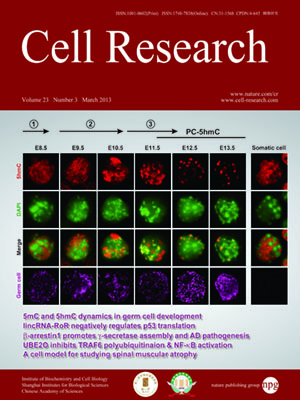
Volume 23, No 3, Mar 2013
ISSN: 1001-0602
EISSN: 1748-7838 2018
impact factor 17.848*
(Clarivate Analytics, 2019)
Volume 23 Issue 3, March 2013: 340-350
ORIGINAL ARTICLES
The human long non-coding RNA-RoR is a p53 repressor in response to DNA damage
Ali Zhang1,*, Nanjiang Zhou1,*, Jianguo Huang1,*, Qian Liu1, Koji Fukuda 1, Ding Ma2, Zhaohui Lu3, Cunxue Bai4, Kounosuke Watabe1 and Yin-Yuan Mo1,5
1Department of Medical Microbiology, Immunology and Cell Biology, Southern Illinois University School of Medicine, Springfield, IL 62794-9621, USA
2Cancer Biology Research Center, Tongji Hospital, Tongji Medical College, Huazhong University of Science and Technology, Wuhan, Hubei 430030, China
3Department of Endocrinology, PLA General Hospital, Beijing 100853, China
4Department of Pulmonary Medicine, Zhongshan Hospital, Fudan University, Shanghai 200032, China
5Cancer Institute, University of Mississippi Medical Center Cancer Institute, 2500 N State St, Guyton 2, Suite G651, Jackson, MS 39216-4505, USA
Correspondence: Yin-Yuan(ymo@umc.edu)
It is well known that upon stress, the level of the tumor suppressor p53 is remarkably elevated. However, despite extensive studies, the underlying mechanism involving important inter-players for stress-induced p53 regulation is still not fully understood. We present evidence that the human lincRNA-RoR (RoR) is a strong negative regulator of p53. Unlike MDM2 that causes p53 degradation through the ubiquitin-proteasome pathway, RoR suppresses p53 translation through direct interaction with the heterogeneous nuclear ribonucleoprotein I (hnRNP I). Importantly, a 28-base RoR sequence carrying hnRNP I binding motifs is essential and sufficient for p53 repression. We further show that RoR inhibits p53-mediated cell cycle arrest and apoptosis. Finally, we demonstrate a RoR-p53 autoregulatory feedback loop where p53 transcriptionally induces RoR expression. Together, these results suggest that the RoR-hnRNP I-p53 axis may constitute an additional surveillance network for the cell to better respond to various stresses.
Cell Research (2013) 23:340–350; doi:10.1038/cr.2012.164; published online 4 December 2012
FULL TEXT | PDF
Browse 2241


